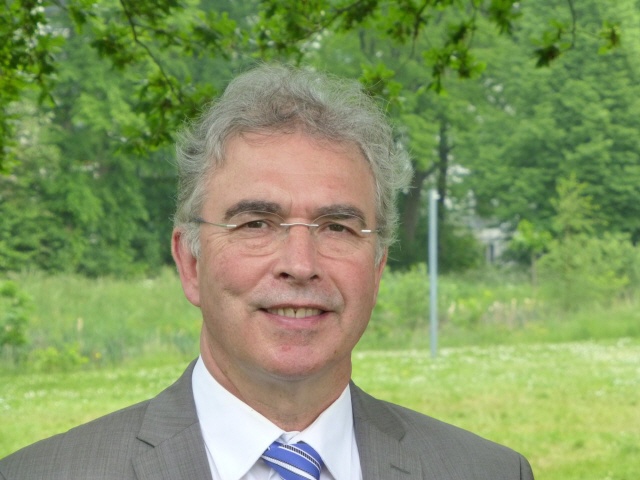Prof. Dr. John Burrows

1972 – 75 Studied Natural Sciences, at Trinity College, University of Cambridge, UK; 1975 B.A. (Hons); 1979 M.A., Ph.D. Cambridge University `Study of free radical reactions by lasermagnetic resonance'; Professor in Bremen since 1992.
Scientific Career:
1978 – 79 Harvard-Smithsonian Center for Astrophysics, Cambridge, Massachusetts, USA; 1979 – 82 A.E.R.E Harwell, Environmental and Medical Science Division, Didcot, Oxfordshire, UK; Guest Scientist at the Physical Chemistry Laboratory, University of Oxford, UK; 1982 – 92 Max Planck Institute for Chemistry, Mainz, Germany
- E-mail: burrows@iup.physik.uni-bremen.de
- Homepage: http://www.iup.uni-bremen.de
- This department of the Institute of Environmental Physics focuses on the study of the atmospheric physics and chemistry of relevance to atmospheric ozone, air pollution and climate problems (key words: ozone hole, smog, greenhouse effect). Our research aims to improve our understanding of the processes involved, comprising:
- conceptual and scientific support to the development and exploitation of remote sensing of the atmosphere from space
- in situ and remote sensing measurement techniques for the retrieval of atmospheric constituents from ground-based, aircraft, balloon and satellite platforms,
- laboratory studies of the kinetics and spectroscopy of important atmospheric constituents,
- the numerical modelling of atmospheric processes to test our understanding and current theory.
- Atmospheric remote sensing from space
- This is an important aspect of this department. Since 1995 the Global Ozone Monitoring Experiment (GOME) aboard the European ERS-2 satellite is taking measurements to observe the changing behaviour of the stratospheric ozone layer, important for the absorption of biologically damaging UV radiation. In addition, GOME is probing the troposphere and making measurements of relevance for pollution and air quality. GOME is the forerunner and smaller version of SCIAMACHY (SCanning Imaging Absorption Spectrometer for Atmospheric CHartographY). Both instruments are spectrometers designed to measure sunlight, transmitted, reflected and scattered by the Earth's atmosphere or surface in the ultraviolet, visible and near infrared wavelength region. Numerical inversion of these spectra yields the amounts and height distributions of atmospheric constituents. GOME has now made over seven years of successful measurements, whereas SCIAMACHY was launched aboard the ESA ENVISAT earth observation satellite on February 28, 2002. In addition, the group is involved in the development and definition of new measurements from space such as those proposed within GeoTROPE (Geostationary TROPospheric Explorer).
- Atmospheric remote sensing: ground-based, from aircraft and balloons
- The DOAS (Differential Optical Absorption Spectroscopy) method is a powerful technique for the retrieval of trace gases. The members of this group operate spectrometers at ground-based sites from the Arctic (Ny-�lesund/Spitsbergen) to the tropics (Nairobi/Kenya), and from airborne platforms. On a campaign basis, some measurements use direct moonlight as a light source instead of the usual scattered sunlight. The airborne instrument called AMAX-DOAS (Airborne Multi AXis DOAS) is a part of the validation campaign of the satellite programme SCIAMACHY, in co-operation with the IUP Heidelberg for the DLR research aircraft Falcon.
- In situ measurements of tropospheric composition
- This research group develops and applies in the atmosphere, techniques to measure a variety of key tropospheric chemical intermediates. The physico-chemical processes in the troposphere are dominated by photochemistry and free radical reactions. A series of photochemical initiated chain reactions results, which cleanse the atmosphere or produce smog, depending on the precise conditions. One important family of free radicals are the peroxy radicals (organic peroxy radicals RO 2 and hydroxyperoxy radical HO 2 ). Chemiluminescence has been exploited successfully in this group for the measurement of the oxides of nitrogen (NO and NO 2 ), RO 2 and peroxyactylnitrate, PAN. These measurements have recently provided evidence for the importance of halogen chemistry in the remote marine boundary layer.
- Aerosol studies
- Aerosols are created in the atmosphere as a result of both natural and atmospheric pollution. They are important both for the radiation balance within the atmosphere and in multiphase chemical transformation. Inaddition they impact directly on air quality and have adverse effects on human health. The objective of the aerosol research group is to improve our understanding of atmospheric aerosol. One important emphasis is the study of tropospheric aerosol from ground-based and satellite borne instrumentation: the development of novel retrieval algorithms being one important activity.
- Laboratory studies
- In order to interpret the measurements and to model processes accurately, spectroscopic and kinetic parameters are required. The objective of our laboratory group is therefore to provide accurate reference data for atmospheric remote sensing and to study molecular physical and chemical parameters of atmospheric significance. This group discovered, for example, the iodine dioxide molecule OIO, which facilitated its subsequent observation in the atmosphere. Advanced laboratory techniques are being developed and used, including flash photolysis coupled with time resolved absorption spectroscopy employing spectrographs, coupled CCDs and Fourier Transform Spectroscopy.
- Modelling group
- The objective of our modelling group is to test our understanding of atmospheric physics and chemistry by comparing model predictions with measurements. To achieve this objective a hierarchy of atmospheric models is required. Thus the group focuses on the scientific exploitation of the combination of models and measurements from satellite, ground-based and aircraft platforms to study both stratospheric and tropospheric issues. Significant progress has been made by this group on the understanding of atmospheric bromine.
